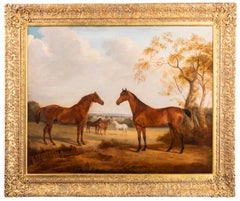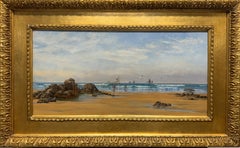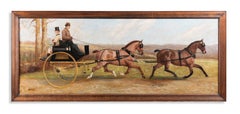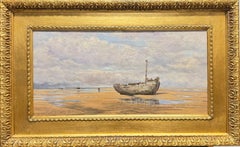Want more images or videos?
Request additional images or videos from the seller
1 of 8
William AndersonFigures unloading a boat at low tide, off Margate
$9,994.93List Price
About the Item
- Creator:William Anderson (1757 - 1837, British)
- Dimensions:Height: 21 in (53.34 cm)Width: 30 in (76.2 cm)
- Medium:
- Movement & Style:
- Period:
- Condition:
- Gallery Location:Stoke, GB
- Reference Number:1stDibs: LU446314956832
William Anderson
William (or Wiliam) Anderson (1757 – 27 May 1837) was a Scottish artist specializing in maritime and patriotic themes. He was well-regarded for his detailed and accurate portraits of ships under sail, exhibiting his works annually in London between 1787 and 1811 and then occasionally until 1834. Anderson influenced other artists, notably John Ward and others of the Hull school. Anderson's early life is obscure, but he is known to have trained as a shipwright before moving to London to become a maritime painter when he was about 30. His training served him well as a painter, providing "a practical nautical knowledge" of his subjects. He earned a reputation for "accuracy and refinement of detail" and was admired for his bright, clear colours. He worked in both oils and watercolours. He based his style on that of well-known Dutch maritime painters of the 17th century. He first exhibited at the Royal Academy in 1787 and the Royal Institution in 1810, and continued to exhibit annually until 1811. He then exhibited intermittently until 1834.[6] His best work was executed in the years 1790–1810, during the French Revolutionary and Napoleonic Wars, at which time the demand for naval paintings was high. His painting was not restricted to marine subjects and included an exhibit in 1822 of a painting depicting the Battle of Waterloo. Like other artists of the time, Anderson's paintings of marine incidents were often based on sketches by participants and were bought by individuals who had risen in social standing and wealth during the wars. Commissions that took Anderson back north introduced him to the Hull school of painters, notably influencing the young John Ward (1798–1849), who copied at least one of Anderson's paintings. He was also a friend and possibly a collaborator of the painter Julius Caesar Ibbetson (1759–1817). His work was influenced by his travels in the North, which led to depictions of Berwick-on-Tweed and Tynemouth. His last exhibit was of Lord Howe's fleet at Spithead at the Royal Academy in 1834, the last of 45 paintings that he exhibited there. He died in London on 27 May 1837.
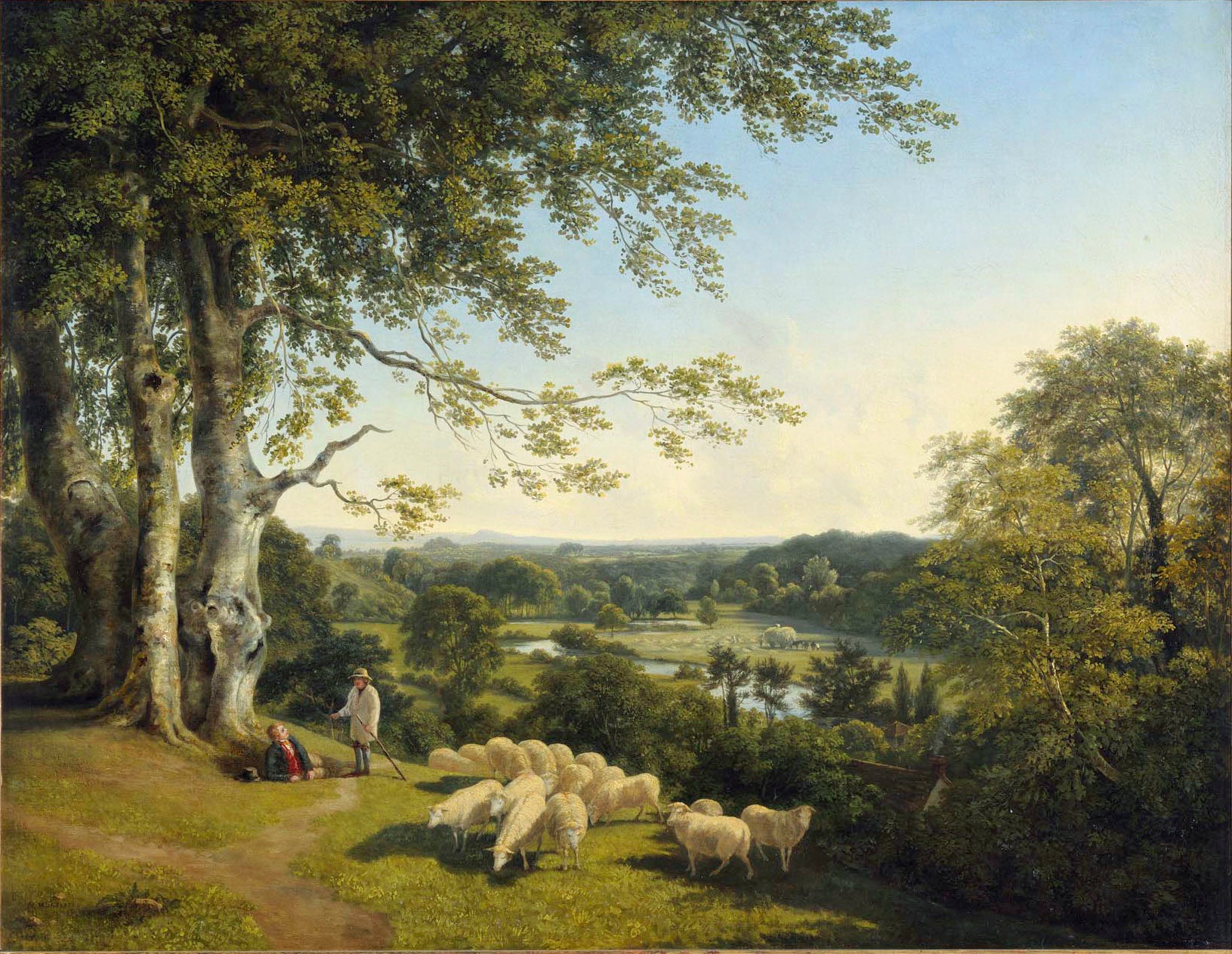
About the Seller
5.0
Recognized Seller
These prestigious sellers are industry leaders and represent the highest echelon for item quality and design.
Platinum Seller
Premium sellers with a 4.7+ rating and 24-hour response times
Established in 2009
1stDibs seller since 2016
187 sales on 1stDibs
Associations
LAPADA - The Association of Arts & Antiques DealersInternational Confederation of Art and Antique Dealers' AssociationsThe British Antique Dealers' Association
Authenticity Guarantee
In the unlikely event there’s an issue with an item’s authenticity, contact us within 1 year for a full refund. DetailsMoney-Back Guarantee
If your item is not as described, is damaged in transit, or does not arrive, contact us within 7 days for a full refund. Details24-Hour Cancellation
You have a 24-hour grace period in which to reconsider your purchase, with no questions asked.Vetted Professional Sellers
Our world-class sellers must adhere to strict standards for service and quality, maintaining the integrity of our listings.Price-Match Guarantee
If you find that a seller listed the same item for a lower price elsewhere, we’ll match it.Trusted Global Delivery
Our best-in-class carrier network provides specialized shipping options worldwide, including custom delivery.You May Also Like
Arrest of Father Curtis - 19th Century Oli Painting of Peninsular War Napoleon
By Robert Alexander Hillingford
Located in Gerrards Cross, GB
‘The Arrest of Father Curtis’ by Robert Alexander Hillingford (1825-1904).
The painting – which depicts occupying French soldiers serving the hero of the Catalan resistance Don Pat...
Category
Mid-19th Century Victorian Figurative Paintings
Materials
Oil
Oil Painting 'The Strid, near Bolton Abbey Wharfedale' by Walter Williams
By Walter Williams
Located in Mere, GB
Oil Painting 'The Strid, near Bolton Abbey Wharfedale' by Walter Williams. Walter Williams 1835-1906 was a painter of the highly popular Williams family o...
Category
19th Century Victorian Landscape Paintings
Materials
Oil
$5,514 Sale Price
24% Off
H 38 in W 46 in D 3 in
Portrait of Maiden in Coastal Landscape - Scottish Victorian art oil painting
By Robert Fowler
Located in Hagley, England
This stunning Scottish Victorian portrait oil painting is by noted artist Robert Fowler. Painted circa 1893 the composition is of a blonde haired maiden in the foreground, dressed in...
Category
1890s Victorian Portrait Paintings
Materials
Oil
$17,646 Sale Price
20% Off
H 38 in W 46 in D 2 in
Scottish River Mountain Landscape - Victorian art oil painting exhibited artist
By Joseph Farquharson
Located in Hagley, England
A large impressive original Victorian oil painting which was painted circa 1890 by Scottish listed artist Joseph Farquharson RA. This Romantic Scottish landscape view is in fine condition and is framed in a Victorian gilt gallery frame. He was a noted landscape painter of snow scenes around Finzean in Aberdeenshire and often painted at dusk or dawn. This painting however depicts a sublime Scottish river landscape with a river and the mountains in the background. It is a very expansive panoramic view. A large painting in good condition and a lovely example of a 19th century Scottish landscape. Similar examples of his paintings are on display in Kelvingrove Art Gallery Glasgow and the National Gallery Scotland.
Signed Joseph Farquharson.
Provenance. Scottish collection.
Condition. Oil on canvas. Image size is 37 inches by 27 inches, fine condition.
Framed size is 44 by 34 inches, housed in a gilt gallery frame. Excellent condition.
Born in Edinburgh, Scotland in 1846, Joseph Farquharson combined a long and prolific career as a painter with his inherited role as a Scottish laird. He painted in both oils and water colors. His mother, a celebrated beauty, was an Ainslie. His early days were spent in his father's house in Northumberland Street below Queen Street Gardens and later at Eaton Terrace beyond the Dean Bridge, Edinburgh and at Finzean. His father Francis was a doctor and laird of Finzean in Aberdeenshire. Joseph was educated in Edinburgh and permitted by his father to paint only on Saturdays using his father’s paint box. When Joseph reached the age of 12, Francis Farquharson bought his son his first paints he could call his own and only a year later he exhibited his first painting at the Royal Scottish Academy. His first major portrait was of ' Miss Alice...
Category
1890s Victorian Landscape Paintings
Materials
Oil
$15,440 Sale Price
20% Off
H 34 in W 44 in D 2 in
Cattle Watering in a Landscape - British 19th century art Victorian oil painting
By Samuel Bough
Located in Hagley, England
This lovely British Victorian landscape oil painting is attributed to noted artist Sam Bough. It was painted circa 1855 after Bough had moved to Hamilton Lanarkshire in Scotland to focus on painting landscapes along side fellow artist Alexander Frazer. The composition is several cattle watering in a stream under the boughs of an ancient tree. There is superb impasto, for example on the clouds and this is a charming 19th century oil painting.
Provenance. London estate.
Condition. Oil on canvas, 29 inches by 16 inches unframed and in good condition.
Frame. Housed in an ornate gilt Victorian frame, 36 inches by 23 inches framed and in good condition.
Samuel Bough RSA (1822–1878) was an English-born landscape painter who spent much of his career working in Scotland. He was born the third of five children in Abbey Street, Carlisle in northern England, the son of James Bough (1794-1845), a shoemaker, and Lucy Walker, a cook. He was raised in relative poverty, but with a keen encouragement in the arts. He was self-taught but mixed with local artists such as Richard Harrington and George Sheffield, and was strongly influenced by the work of Turner. After an unsuccessful attempt to live as an artist in Carlisle he obtained a job and as a theatre scenery painter in Manchester in 1845, later also working in Glasgow in the same role. Encouraged by Daniel Macnee to take up landscape painting he moved to Hamilton from 1851-4 and worked there with Alexander Fraser. In 1854 he moved to Port Glasgow to work on his technique of painting ships and harbours. His paintings were noted for their sensitivity to atmosphere and light, were often of cloudy shorelines and busy harbours. He also began supplementing his income by illustrating books, before moving to Edinburgh in 1855. On coming to Edinburgh he lived in a terraced house at 5 Malta Terrace in the Stockbridge area of the city. Following Turner's example, he became a skilful painter of seaports. He was buried in Dean Cemetery Edinburgh on 23 November 1878. The grave bears a bronze medallion of his head by William Brodie...
Category
1850s Victorian Landscape Paintings
Materials
Oil
$3,749 Sale Price
20% Off
H 23 in W 36 in D 2 in
Landscape with Cattle - Surrey - British Victorian art 19th century oil painting
By George William Mote
Located in Hagley, England
This charming Victorian landscape oil painting is by noted prolific exhibited British artist George William Mote. Mote was very fond of painting landscapes in Surrey and this is a pa...
Category
1880s Victorian Landscape Paintings
Materials
Oil
$4,411 Sale Price
20% Off
H 31 in W 43 in D 2 in
Portrait of Two Horses in a Landscape - British 19thC equine art oil painting
By George Cole
Located in Hagley, England
This lovely British Victorian oil painting is attributed noted landscape and animal artist George Cole ans ascribed verso. Painted in 1840 it is a superb portrait of two horses, one ...
Category
1840s Victorian Animal Paintings
Materials
Oil
$7,720 Sale Price
20% Off
H 32 in W 37 in D 2 in
Highland Landscape - Scottish Victorian art oil painting Scotland
Located in Hagley, England
This gorgeous Scottish Victorian landscape oil painting is by noted artist Robert McGown Coventry, also known as Robert Coventry. Painted circa 1890 it is a spring Highland landscape...
Category
1890s Victorian Landscape Paintings
Materials
Oil
Robert McGowan CoventryHighland Landscape - Scottish Victorian art oil painting Scotland, Circa 1890
$6,617 Sale Price
20% Off
H 35 in W 43 in D 2 in
Figurative Coastal Landscape - British c 1850 Victorian art oil painting
By Edward Robert Smythe
Located in Hagley, England
This interesting British 19th century coastal landscape oil painting is by noted Suffolk School artist Edward Robert Smythe. Painted circa 1850 it is a busy coastal landscape with fi...
Category
1850s Victorian Landscape Paintings
Materials
Oil
$9,926 Sale Price
20% Off
H 31 in W 43 in D 2 in
Drover with Cattle in Landscape - British 19thC Victorian art oil painting
By Frederick Waters Watts
Located in Hagley, England
This lovely British 19th century landscape oil painting is by noted artist Frederick Waters Watts. Painted circa 1840, the composition is a drover with cattle watering in an extensiv...
Category
1840s Victorian Landscape Paintings
Materials
Oil
$7,499 Sale Price
20% Off
H 27 in W 37 in D 2 in
More From This Seller
View AllThe Duke of Wellington's 'Copenhagen', ridden at the Battle of Waterloo
By William Webb
Located in Stoke, Hampshire
William Webb (1780-1846)
The Duke of Wellington's 'Copenhagen', ridden at Waterloo, Sir John Waters' 'Bitter', the Duke of Wellington's chestnut mare, the Duke of Wellington's white ...
Category
19th Century Victorian Animal Paintings
Materials
Oil
Glorious Summer', Newquay, Cornwall
Located in Stoke, Hampshire
John Brett A.R.A. (1831-1902)
Glorious Summer', Newquay, Cornwall
Oil on canvas
Canvas Size - 12 3/8 x 25 3/8 in
Provenance
The Collection of F C Mills by 1884;
C J Robin by 1893; ...
Category
19th Century Victorian Landscape Paintings
Materials
Oil
A horse-drawn buggy on a track, a hunt beyond
By George Paice
Located in Stoke, Hampshire
George Paice (1854-1925
A horse-drawn buggy on a track, a hunt beyond
signed and dated lower left
Oil on canvas
Canvas size 23 x 60 in
Framed size 27 x 65 in
Provenance
The Collecti...
Category
19th Century Victorian Animal Paintings
Materials
Oil
'The winter of our discontent when we took the bar to the ebb', Newport, Wales
Located in Stoke, Hampshire
John Brett A.R.A. (1831-1902)
The winter of our discontent when we took the bar to the ebb', Newport, Wales
Oil on canvas
Canvas Size - 12 3/8 x 25 3/8 in
Provenance
Acquired from the artist by C J Robin in December 1882 for £150;
Private collection
Literature
C Payne...
Category
19th Century Victorian Landscape Paintings
Materials
Oil
Snipe Shooting
By Samuel Alken Jnr.
Located in Stoke, Hampshire
Samuel Alken Jnr (1784-1825)
Snipe Shooting
Signed 'S. Alken'
Oil on canvas
Painting Size - 12 x 16 1/2 in
Framed Size - 17 x 21 1/2 in
Samuel Alken Junior (1784–1825)
Samuel Alken ...
Category
19th Century Victorian Landscape Paintings
Materials
Oil
A bay hunter in a landscape, a view of Windsor castle beyond
By Edmund Bristow
Located in Stoke, Hampshire
Edmund Bristow (1787-1876)
A bay hunter in a landscape, Windsor castle beyond
Signed with initials lower left
Oil on canvas
Canvas Size 22 1/2 x 27 1/2 in
Framed Size 27 x 32 in
Pro...
Category
19th Century Victorian Animal Paintings
Materials
Oil
$10,973 Sale Price
20% Off
Recently Viewed
View AllMore Ways To Browse
Battle Ship
Navy Oil Painting 18th Century
Nile Painting
Hms Victory
Realistic Landscape Oil Paintings
Riviera Paintings France
Robert Wood Paintings For Sale
Sailing Ships Oil Painting
Tropical Impressionist
Vintage Ambulance
Wisteria Art
American Red Cross
California Abstract Landscapes
California Impressionist Seascape Paintings
Giverny Art
Gloucester Harbor
Hawaiian Landscape Painting
Hay Bales

